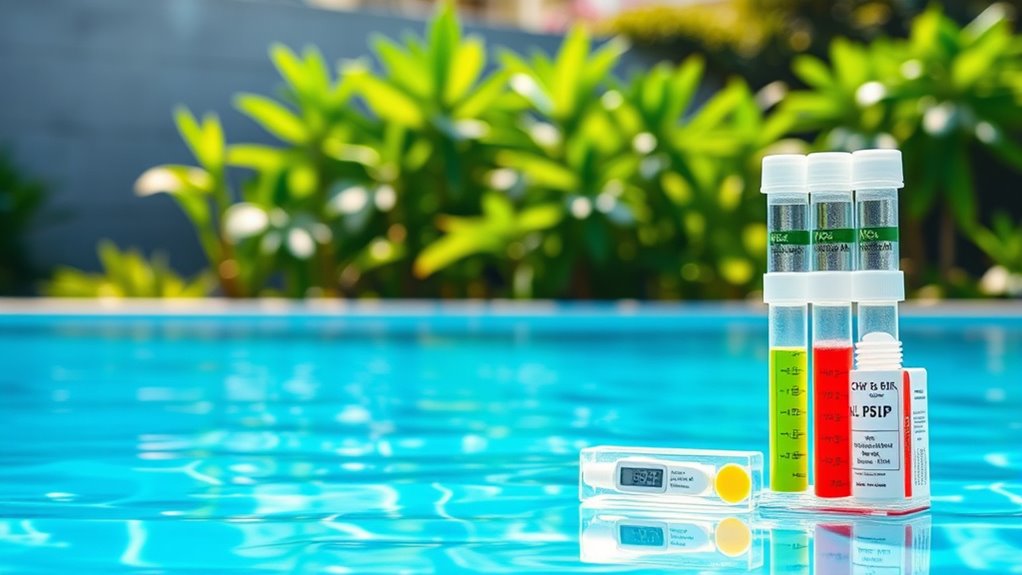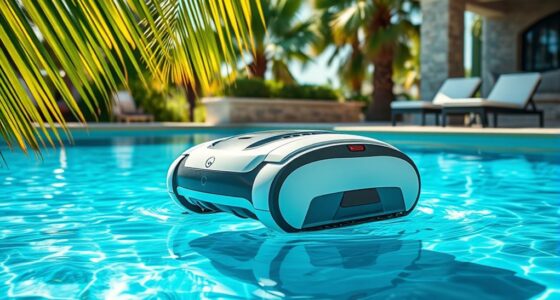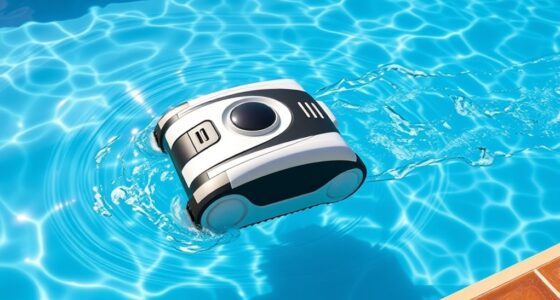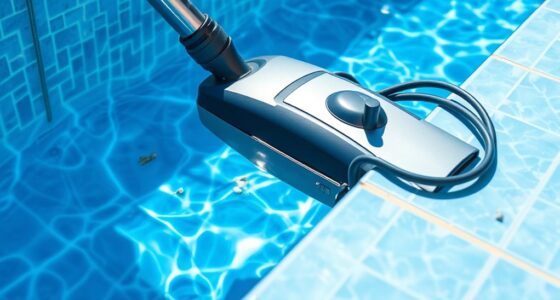To keep your pool water safe and inviting, regularly test and balance the chemistry. Maintain chlorine levels between 1-3 ppm to disinfect the water effectively, and keep pH between 7.2 and 7.6 for *ideal* sanitation and comfort. Use test kits or strips to monitor levels, and adjust chlorine or pH using appropriate chemicals as needed. Staying on top of these basics ensures a clean pool and healthier swim — discover more tips to perfect your pool’s chemistry.
Key Takeaways
- Regularly test chlorine levels to keep free chlorine between 1-3 ppm for effective disinfection.
- Maintain pH between 7.2 and 7.6 to optimize sanitizer efficiency and swimmer comfort.
- Use reliable test kits or strips to monitor water chemistry consistently.
- Adjust pH with appropriate chemicals—add pH increasers or decreasers as needed.
- Proper balancing of chlorine and pH prevents algae growth, bacteria, and equipment damage.

Have you ever wondered what keeps your pool water clean, clear, and safe to swim in? The answer lies in proper pool chemistry, especially maintaining the right chlorine levels and pH balancing. These two aspects are essential because they work together to prevent bacteria, algae, and other contaminants from turning your pool into an uninviting, unsafe environment. When you keep your chlorine levels in check, you’re actively disinfecting the water, killing germs, and breaking down organic matter introduced by swimmers and the environment. But chlorine’s effectiveness isn’t just about how much you add; it also depends on the pH of your water. If your pH is too high or too low, it can hinder chlorine’s ability to sanitize effectively. That’s why pH balancing is a crucial part of maintaining healthy pool water.
To keep your chlorine levels ideal, you should test your water regularly—at least once a week, especially during peak swimming season. Use a reliable test kit or pool testing strips to check the free chlorine concentration. Ideally, it should be between 1 and 3 parts per million (ppm). If levels drop below that, your water becomes vulnerable to bacteria and algae, and if they’re too high, it can cause skin and eye irritation. Adjustments are straightforward: add chlorine tablets, liquid chlorine, or shock treatment if needed. Always follow the manufacturer’s instructions to avoid over-chlorination, which can also cause problems.
Simultaneously, pay attention to pH balancing, which should be maintained between 7.2 and 7.6. This range is just right for chlorine to work efficiently and for your skin and eyes to stay comfortable. Test the pH using test strips or a digital meter, and if it’s outside the ideal range, use pH increasers or decreasers available at pool stores. For example, if your pH is too high, adding a pH decrease product will help bring it down. Conversely, if it’s too low, a pH increaser will raise it. Consistent pH balancing not only enhances chlorine’s effectiveness but also prevents corrosion of pool equipment and staining of the pool surface.
Frequently Asked Questions
How Often Should I Test My Pool Water?
You should test your pool water at least twice a week to keep it balanced. Regular water testing is essential for effective pool maintenance, helping you monitor pH, chlorine levels, and other important factors. If your pool gets heavy use or after a storm, test more frequently. Staying on top of water testing guarantees safe, clear water and prevents issues like algae growth or cloudy water.
Can Pool Chemicals Be Mixed Together?
Mixing pool chemicals is like juggling fire; it can be dangerous if not done correctly. You should never combine chemicals unless the instructions explicitly say so. Always follow chemical safety and storage guidelines, keeping chemicals separate and in labeled containers. This prevents dangerous reactions that could harm you or damage your pool. When in doubt, add chemicals one at a time, and always wear protective gear for your safety.
What Should I Do if My Pool Turns Green?
If your pool turns green, you need to act quickly to restore water clarity and prevent algae growth. Shock the pool with a chlorine-based algaecide, following the instructions carefully. Brush the pool walls and vacuum to remove algae. Regular algae prevention measures, like maintaining proper chlorine levels and filtration, help keep your water clear. Staying consistent with these steps guarantees your pool stays inviting and algae-free.
How Do I Prevent Algae Growth?
To prevent algae growth, you need to focus on algae prevention by maintaining proper chemical levels and ensuring chemical compatibility. Regularly test and balance your pool’s pH, alkalinity, and sanitizer levels to inhibit algae spores from thriving. Use algaecides as a preventive measure, especially during warm weather or when the pool isn’t in use. Consistent circulation and filtration also help keep algae at bay, ensuring clear, healthy water.
Is It Necessary to Drain and Refill My Pool Regularly?
You don’t always need to drain and refill your pool regularly. Instead, focus on maintaining proper water chemistry, which helps prevent issues like algae and cloudiness. If your water becomes very cloudy, has a strong odor, or contains persistent algae, then consider a pool drain and water refill. Regularly testing and balancing chemicals reduces the need for a full water replacement, saving you time and effort.
Conclusion
Now that you understand the basics of pool chemistry, maintaining crystal-clear water becomes second nature. Think of balancing your water as a delicate dance—each chemical plays its part, creating harmony rather than chaos. With your newfound knowledge, you’ll enjoy invigorating swims in a pristine pool, free of worries. Just like a well-tuned instrument, your pool will shine beautifully, inviting you to relax and unwind, knowing every detail is perfectly in sync.










